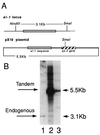Isolation of quelling-defective (qde) mutants impaired in posttranscriptional transgene-induced gene silencing in Neurospora crassa
- PMID: 9294193
- PMCID: PMC23345
- DOI: 10.1073/pnas.94.19.10233
Isolation of quelling-defective (qde) mutants impaired in posttranscriptional transgene-induced gene silencing in Neurospora crassa
Abstract
We report the isolation of 15 Neurospora crassa mutants defective in "quelling" or transgene-induced gene silencing. These quelling-defective mutants (qde) belonging to three complementation groups have provided insights into the mechanism of posttranscriptional gene silencing in N. crassa. The recessive nature of the qde mutations indicates that the encoded gene products act in trans. We show that when qde genes are mutated in a transgenic-induced silenced strain containing many copies of the transgene, the expression of the endogenous gene is maintained despite the presence of transgene sense RNA, the molecule proposed to trigger quelling. Moreover, the qde mutants failed to show quelling when tested with another gene, suggesting that they may be universally defective in transgene-induced gene silencing. As such, qde genes may be involved in sensing aberrant sense RNA and/or targeting/degrading the native mRNA. The qde mutations may be used to isolate the genes encoding the first components of the quelling mechanism. Moreover, these quelling mutants may be important in applied and basic research for the creation of strains able to overexpress a transgene.
Figures






References
-
- Finnegan J, McElroy D. Bio/Technology. 1994;12:883–888.
-
- Vaucheret H. C R Acad Sci Paris. 1993;316:1471–1483.
-
- Park Y D, Papp I, Moscone E A, Iglesias V A, Vaucheret H, Matzke A J M, Matzke M A. Plant J. 1996;9:183–194. - PubMed
Publication types
MeSH terms
LinkOut - more resources
Full Text Sources
Other Literature Sources
Research Materials

